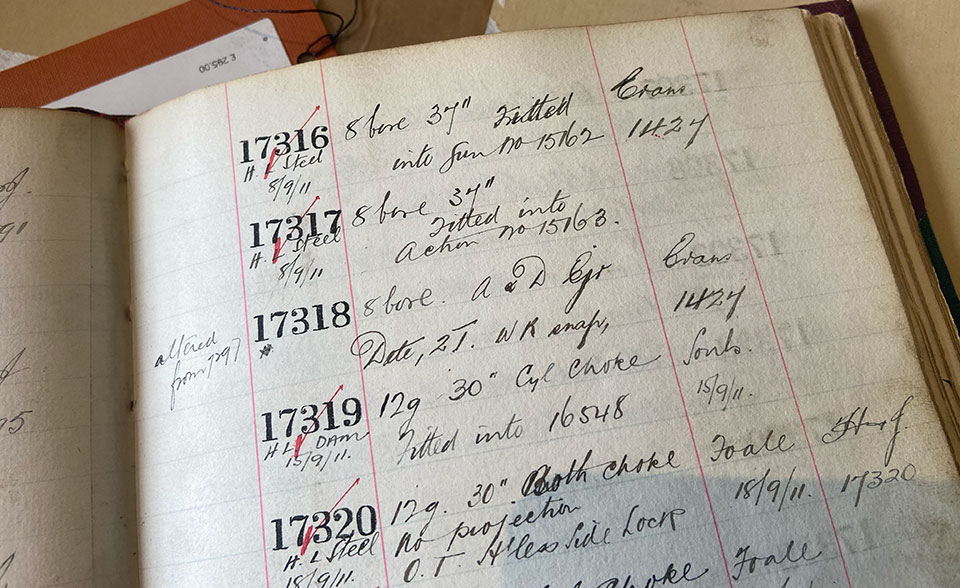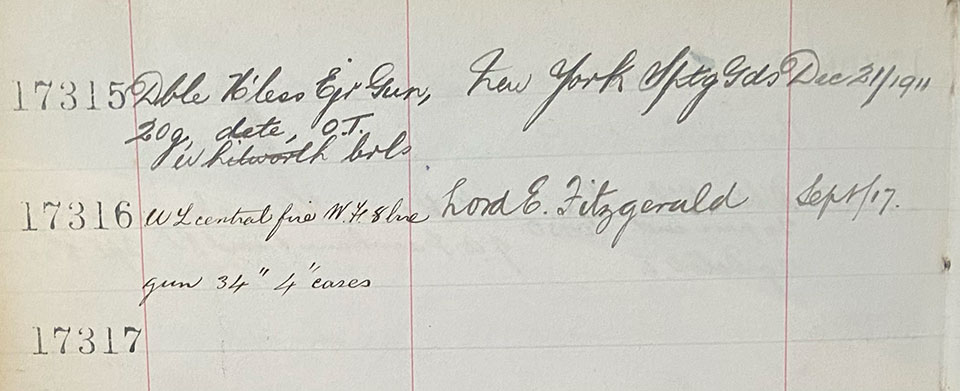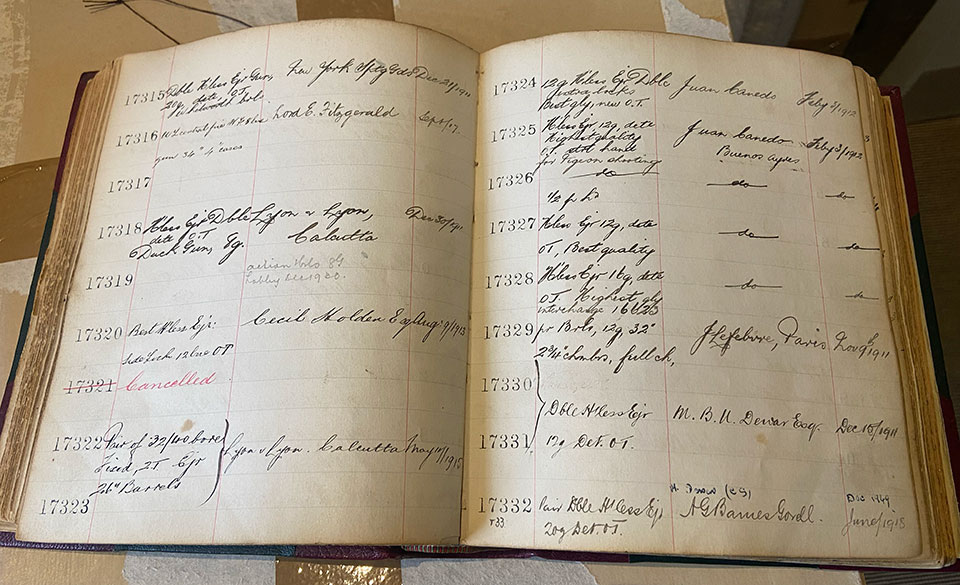The first quarter of the 20th century posed questions for gunmakers with large factories, like Westley Richards.
The company was producing large numbers of guns and rifles as the 1800s turned into the 1900s. In order to do so, the factory must have been well-stocked with all the necessary parts to make them. If this were not the case, production would have been slowed when there was an interruption in supply.
Any production manager will tell you that time is money, so we can well imagine that Bournbrook (the Westley Richards factory from 1898-2008) had guns ‘in the white’ as well as plenty of barrels, actions, locks and furniture forgings, all ready to be used when needed.
The problem with this practice was that industry and engineering, as well as chemistry, were changing the requisites of the sportsman quite considerably. As a result, guns and gunmaking were changing rapidly as well.
The development of increasingly diverse and better ‘hammerless’ actions, in the mid-to-late 1800s, impacted production and so did the ‘smokeless’ ammunition which the new guns were made to fire. In many cases, the latter necessitated changes to the former.
The double rifle of the 1800s was made to propel huge lead balls or conical bullets, driven by large charges of black powder. No self-respecting big game hunter left for Africa or India without a double 8-bore rifle.
The advent of the 1897 Holland & Holland ‘Paradox’, which allowed for the use of shot or ball in the same weapon cemented the big double’s reputation as an essential inclusion in the battery. Westley Richards offered their own 12-bore version of the Paradox and called it the ‘Explora’, the ‘Fauneta’ was the same gun/rifle in 20-bore or 28-bore.
By the time Westley Richards published their 1912 catalogue, the guns offered within its pages appear thoroughly modern. They are predominantly hammerless boxlock (Anson & Deeley 1875 patent) or detachable-lock (Taylor patent of 1897), ejectors, with single-trigger options.
The shot & ball ‘Explora and ‘Fauneta’ feature prominently but they have dispensed with the old black powder loads and are touted as sophisticated all-rounders, accurate to 300 yards as rifles and effective as shotguns.
The special’ L-T’ capped bullets, whose ‘tremendous penetrative force and smashing power… have been fully proved in independent trials ‘ according to the literature of the day, were essential accompaniments.
Perusing the 1912 catalogue, it is notable that not a single large bore hammer gun is advertised. ‘Long Range Wildfowl Guns’ do appear in bores 10, 8 and 4 but all are hammerless (Anson & Deeley actions). They are proof-tested for bulk nitro powders (with black powder equivalent information provided).
It is, therefore apparent that, as a forward-looking company, Westley Richards had decided by 1912 that single-trigger, hammerless guns and rifles, consuming nitro ‘smokeless’ powders, were now their main focus.
the order books tell a slightly different story.
However, the order books tell a slightly different story. Among the orders for single-trigger hand-detachable lock game guns and double rifles, there appears the occasional denotation of the sale of a large-bore hammer gun.
One such gun appears listed as serial number 17316, with the date 8th September 1911 next to it. It is a double 8-bore hammer gun. Number 17317 is also a double 8-bore hammer gun and number 17319 is a 12-bore hammer gun.

What is interesting about these entries is the wording; ‘fitted into’ that features in the description. Number 17316 was ‘fitted into gun No. 15162’, while Number 17319 was ‘fitted into 16548’ according to the order book. What might have been going on?
If we return to the first gun in this sequence, (and remember, so far, we have looked at just one page of the 1911 order book); Serial Number 17316, and cross reference it with Serial Number 15162, we can see that 17316 is listed as a 1911 double 8-bore hammer gun with 37” steel barrels ‘fitted into 15162’, which is listed on July 31st 1899 as a ‘double 8-bore, both choke’. In the margin it states ‘Paris Exhibition’.
Serial Number 17316 appears again in another book dated September 1917 and lists the gun as a ‘central fire 8-bore gun 34” barrels, 4” cases’. It was sold to Lord Edward FitzGerald (who happens to be my great-great-uncle). He bought several guns and rifles from Westley Richards between 1911 and 1920 but, rather embarrassingly, didn’t always pay for them.
guns and rifles, dating from the late 1890s, may have been left in-the-white as part-made
The other serial numbers mentioned above appear under their previous numbers as similarly-aged hammer guns or double rifles. So, we can begin to form a picture that some of these guns and rifles, dating from the late 1890s, may have been left in-the-white as part-made (or un-sold) guns or rifles and then been overtaken by developments in the industry, mothballed for a decade and then re-purposed as big wildfowl guns later, at a time when there was still some demand for these on the foreshore but little demand for black-powder rifles.
Still, these investigations elicit questions, as well as answers. It is unlikely that any of these guns will be available for inspection, so speculation is largely paper-based.
However, one of those listed above is available: the double 8-bore made for my debauched ancestor, Lord Edward FitzGerald, Serial Number 17316. It appeared recently in the listings of a British gun dealer and we took the opportunity to examine it. It has 34” steel barrels, choked Full & Full, 4 ½” chambers (we have not measured these but the order book states 4” chambers) and a 14 ½” stock. It weighs 14lbs and has a plain, dolls’ head action, (which was very likely nickel plated when new), with Jones under-lever and screw-grip and rebounding back-locks.

So far, so normal, readers may be thinking. However, look closer and we see a well-figured pistol-grip stock, with an extended top-strap, which bridges the hand and is fixed into the comb. It has a correspondingly protective extended guard strap, locating into a steel grip-cap.
The fine, flat-top chequer and high-quality fit of all the metal parts makes this look more than the average plainly-finished wildfowling 8-bore.
It has a flat, filed rib and a lever grip securing the forend. Many of these features suggest double-rifle style rather than foreshore wildfowler. This impression is amplified by the presence of a cheek-piece on the left side of the stock.
Why Westley Richards would have taken a plain double 8-bore to the Paris exhibition of 1900 is puzzling but the words are clearly written alongside the gun’s original entry.
Westley Richards had a surplus of obsolete hammer actions
What this all suggests to me is that Westley Richards had a surplus of obsolete hammer actions (for big bore rifles and shotguns in particular) in their stores and took what opportunities as presented themselves to sell them.
One might assume they were sold ‘off catalogue’ to drop-in customers looking for something quick to deliver and not averse to an old-fashioned mechanism; perhaps offered at an attractive discount.

If more of these ‘fitted-into’ guns appear in the future, we may be able to extrapolate more in terms of the practices involved in finishing these guns for later sale.
The discrepancies in the order books certainly make for some interesting reflection on what was being discussed and actioned a century ago, in order to use-up obsolete stock and plan how best to make it saleable.
Published by Vintage Guns Ltd on (modified )




